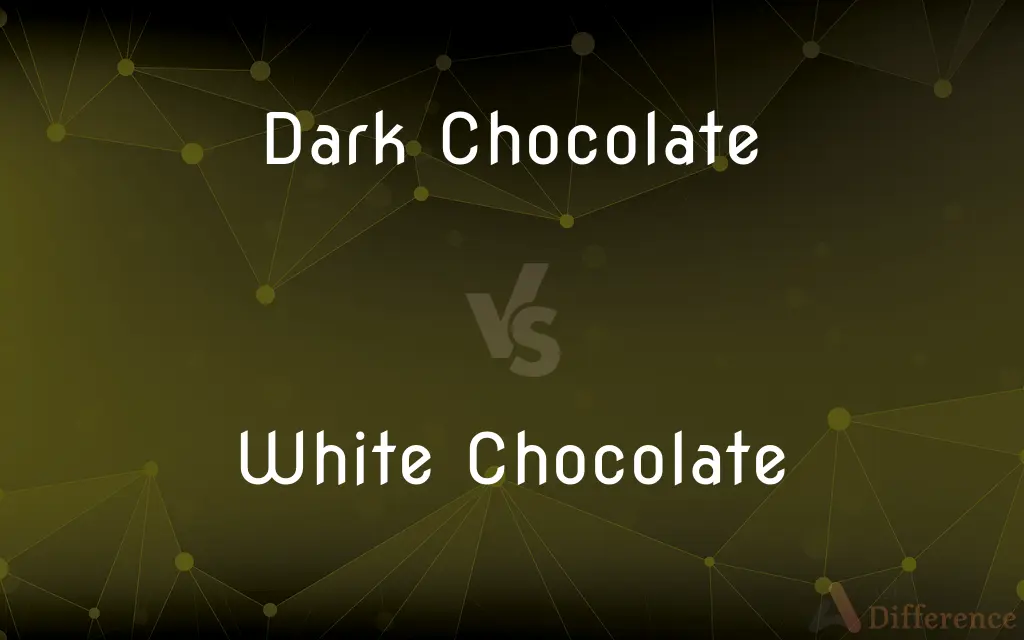Dark Chocolate vs. White Chocolate — What's the Difference?
By Tayyaba Rehman — Published on October 16, 2023
Dark chocolate, made with cocoa solids, cocoa butter, and sugar, has a rich, bitter flavor, while white chocolate, containing cocoa butter, sugar, and milk, is sweeter and creamier.

Difference Between Dark Chocolate and White Chocolate
Table of Contents
ADVERTISEMENT
Key Differences
Dark chocolate and white chocolate, while both delicious, differ significantly in composition, flavor, and nutritional content. Dark chocolate is produced using cocoa solids, cocoa butter, and sugar, often having a higher cocoa content, which gives it a rich, robust, and slightly bitter flavor profile. In contrast, white chocolate is made from cocoa butter, sugar, and milk solids, omitting the cocoa solids, and has a sweet, creamy flavor due to the presence of milk.
The composition of dark chocolate typically allows it to have a range of health benefits. It is richer in antioxidants, minerals such as iron and magnesium, and flavonoids, which have been associated with improved heart health and reduced inflammation. Conversely, white chocolate, lacking cocoa solids, does not offer the same level of antioxidants and tends to be higher in sugar and fat, contributing to its creamy texture and sweet taste.
The appearance and texture of dark chocolate and white chocolate are distinctly different. Dark chocolate, due to the presence of cocoa solids, has a darker, almost black appearance and a firmer texture. White chocolate, on the other hand, is pale ivory in color due to the absence of cocoa solids and has a softer, more melt-in-the-mouth texture, attributed to its higher milk and sugar content.
When considering culinary applications, dark chocolate is versatile and is often used in cooking and baking for its deep, intense flavor, complementing both sweet and savory dishes. It pairs well with a variety of ingredients like fruits, nuts, and spices. White chocolate, with its sweet and mild flavor, is often used in desserts and confections and pairs well with flavors like vanilla, citrus, and berries.
While dark chocolate and white chocolate cater to different taste preferences and have distinct characteristics, both types of chocolate hold a special place in the culinary world, offering diverse flavors and textures to delight the palate.
ADVERTISEMENT
Comparison Chart
Composition
Cocoa solids, cocoa butter, sugar
Cocoa butter, sugar, milk solids
Flavor
Rich, robust, slightly bitter
Sweet, creamy
Nutritional Content
Rich in antioxidants and minerals
Higher in sugar and fat
Appearance & Texture
Dark, almost black, firmer texture
Pale ivory, softer, creamy texture
Culinary Uses
Versatile in sweet and savory dishes
Typically used in desserts and confections
Compare with Definitions
Dark Chocolate
Typically has a higher cocoa content, giving it a robust flavor.
The high cocoa content in dark chocolate contributes to its intense taste.
White Chocolate
Made from cocoa butter, sugar, and milk solids.
White chocolate is sweeter and creamier than its dark counterpart.
Dark Chocolate
Versatile in culinary applications, complementing various ingredients.
Dark chocolate pairs well with fruits, nuts, and even spices.
White Chocolate
Has a higher sugar and fat content, giving it a creamy texture.
The creamy texture of white chocolate makes it ideal for confections.
Dark Chocolate
Known for its high antioxidant and mineral content.
Many prefer dark chocolate for its potential health benefits.
White Chocolate
Typically used in desserts, pairing well with sweet flavors.
White chocolate enhances the flavor of desserts like cheesecakes and mousses.
Dark Chocolate
Has a firmer texture and is darker in color due to cocoa solids.
Dark chocolate’s robust flavor enhances both sweet and savory dishes.
White Chocolate
Lacks cocoa solids, resulting in a pale ivory color.
The absence of cocoa solids gives white chocolate its characteristic color.
Dark Chocolate
A type of chocolate containing cocoa solids, cocoa butter, and sugar.
Dark chocolate has a distinctly rich and slightly bitter flavor.
White Chocolate
Has a sweet, mild flavor due to the presence of milk and sugar.
Many prefer white chocolate for its sweet and mild taste.
Common Curiosities
Does dark chocolate have health benefits?
Yes, dark chocolate is rich in antioxidants and minerals and is associated with various health benefits.
What gives white chocolate its sweet and creamy flavor?
The sweet and creamy flavor of white chocolate comes from milk solids and higher sugar content.
Can dark chocolate be used in savory dishes?
Yes, the intense flavor of dark chocolate complements both sweet and savory dishes.
Is white chocolate richer in antioxidants compared to dark chocolate?
No, white chocolate, lacking cocoa solids, is not as rich in antioxidants as dark chocolate.
What contributes to the firmer texture of dark chocolate?
The presence of cocoa solids contributes to the firmer texture of dark chocolate.
Can people with a sweet tooth enjoy white chocolate?
Yes, people with a sweet tooth often enjoy white chocolate due to its sweet, creamy flavor.
Is white chocolate typically used in desserts?
Yes, white chocolate, with its sweet and mild flavor, is typically used in desserts and confections.
What is the main component in dark chocolate giving it its flavor?
Cocoa solids primarily give dark chocolate its rich and robust flavor.
Does dark chocolate have a higher cocoa content than white chocolate?
Yes, dark chocolate typically has a higher cocoa content as it contains cocoa solids, unlike white chocolate.
Why is white chocolate white in color?
White chocolate is pale ivory in color due to the absence of cocoa solids.
Is dark chocolate versatile in culinary applications?
Yes, the rich, robust flavor of dark chocolate makes it versatile in a variety of culinary applications.
Is dark chocolate bitterer than white chocolate?
Yes, the higher cocoa content in dark chocolate gives it a slightly bitter, more intense flavor compared to white chocolate.
Can white chocolate be paired with citrus flavors?
Yes, the sweet, mild flavor of white chocolate pairs well with citrus and other sweet flavors.
What makes the texture of white chocolate creamy?
The higher milk and sugar content in white chocolate give it a creamy, melt-in-the-mouth texture.
Do dark chocolate and white chocolate cater to different taste preferences?
Yes, with distinct flavors and textures, dark chocolate and white chocolate cater to different taste preferences.
Share Your Discovery

Previous Comparison
Sunflower Oil vs. Vegetable Oil
Next Comparison
DMV vs. RMVAuthor Spotlight
Written by
Tayyaba RehmanTayyaba Rehman is a distinguished writer, currently serving as a primary contributor to askdifference.com. As a researcher in semantics and etymology, Tayyaba's passion for the complexity of languages and their distinctions has found a perfect home on the platform. Tayyaba delves into the intricacies of language, distinguishing between commonly confused words and phrases, thereby providing clarity for readers worldwide.












































